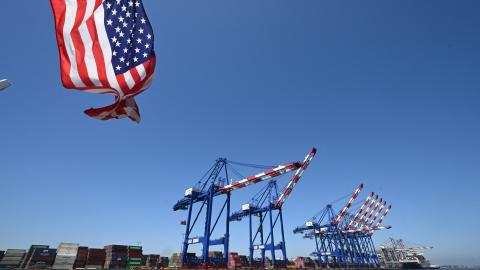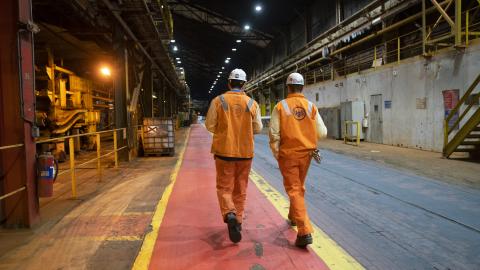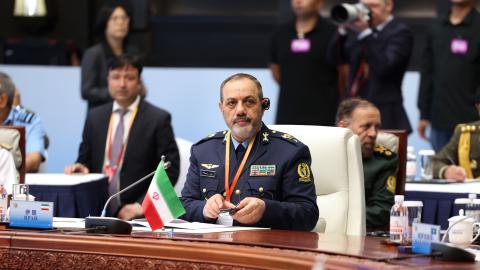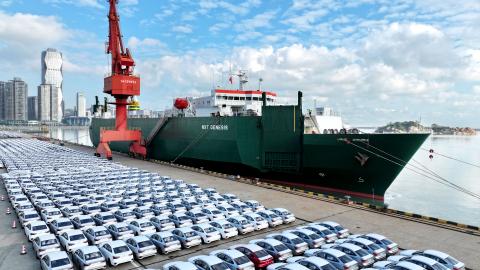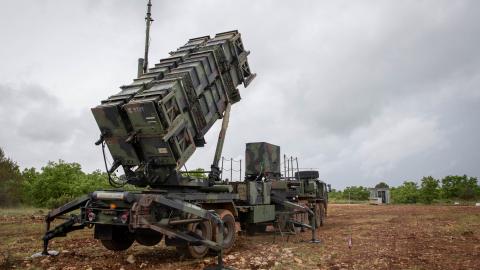China’s aggressive militarism, declining economy, and stagnant leadership has renewed America’s status as the welcome and indispensable force for prosperity and security in Asia.
The conventional wisdom in recent years has been that the United States, reeling from loss of prestige after the Iraq invasion and awash in the foreign policy uncertainty that it created, is overextended and exhausted and now fated to watch impotently as China takes its place. The thesis of American decline, first developed in the 1970s after the United States lost the Vietnam War, was back in vogue. America was not only fading but unable to prevent the arrival of a new Chinese superpower ready and eager to assume pre-eminence and leadership in a region dominated by the United States since the end of the Second World War.
When Barack Obama replaced George W. Bush in 2009, the United States was suffering its worst economic crisis since the Great Depression. At the same time, a rapidly growing China was a decade into “smile diplomacy” in an attempt to reassure neighbors that its rise to power would be peaceful. Putting the best face on these developments, U.S. foreign policy makers acknowledged that America’s exhausted economy probably could not offer opportunities for the region that China’s could, and that a continuing American presence in Asia, if nothing more, would act as a stopgap insurance measure in case China’s peaceful rise morphed into something else.
When a new American president takes office in early 2017, he or she will not be shackled by this gloomy narrative which, in a few short years, has itself suffered what appears to be a fatal decline. The end of China’s brief era of good feelings in favor of a more aggressive and acquisitive stance has changed everything. Few counties in the Pacific any longer trust in the peacefulness of Beijing’s rise. China’s inevitable emergence as an economic superpower is in question as it confronts an economy weighed down by heavy debt and wasteful investment, leading to the certainty of a structural (and not just cyclical) slowdown.
As strategic tensions between China and almost all of its neighbors worsen, once booming trade is slowing in the region. In response, many export-dependent economies are adopting ever more mercantilist trade policies; while in strategic and economic affairs, zero-sum thinking is on the ascendency.
Meanwhile, the American economy, given up for dead, has come back to life in a way that has not escaped notice. The shale energy revolution has made the cost of energy cheaper for American-based firms, thereby improving the country’s competitiveness and balance of trade. Indeed, Asia is now even more dependent on American innovation, capital, and markets than it was a decade ago.
Similarly, the region’s willingness to welcome an American military presence is more widespread and urgent now than at any other time this century or the latter part of the previous one. A decade ago, many countries worried that a declining America would overplay its hand, the fear is now that the next administration might underplay Washington’s hand as some believe President Obama has done too often. This means that the opportunities for a new administration to enhance America’s standing in Asia and enlarge its role in the region are significant.
Since after the Second World War, rapidly developing East Asian economies—Japan, South Korea, Taiwan, Singapore, Malaysia, Thailand and, more recently, China—have all relied on a remarkably similar export-manufacturing development model to grow rich. It was a two-way street that benefited both parties. Asia’s undeveloped countries made and exported products to consumers in advanced economies more cheaply, faster, and more reliably than could be done elsewhere. On the formula’s other side, the developing economies received knowhow, innovation, and capital from firms like General Electric (GE) and Apple that established operations, often joint ventures, in Asia. American commercial giants invested in Asian industry and infrastructure and created millions of well-paying manufacturing jobs for the latter’s young and growing populations. America and its consumers benefitted from the arrangement by applying downward pressure on inflation with people paying lower prices for goods.
As a result, East Asia captured a third of all global manufacturing trade, up from about 10 percent in 1970. More than two-thirds of all finished exports out of Asia end up in North America and Europe. Regional free trade agreements such as the one between China and the Association of Southeast Asian Nations have made East Asia into a vast and integrated production chain that makes products for middleclass consumers around the world, but mostly in Western countries. An iPhone might be “Designed in California,” but the parts and workmanship needed to produce one can come from a dozen countries throughout East Asia.
But this model for prosperity is hitting a wall in Asia. What has worked so well in the past will no longer be as effective for highly populated and poor countries like China, Indonesia, Vietnam, and Burma. In the 1980s, the combined population of exporting powerhouses of Asia—Japan, South Korea, Taiwan, Singapore, and Malaysia—was just above 150 million. At that time, the population of their North American and European consumer markets numbered more than four hundred million. The proportions of this equation have flipped; today, there are some two billion people living in developing countries making and exporting products to one billion consumers living in the advanced economies.
In short, there are too many producers making products for too few consumers, a fact illuminated by statistics that show that global trade may actually be stalling after the runaway years of the previous two decades. Global merchandise exports as a percentage of GDP increased from about 15 percent where it had stood for a number of years prior in the early 1990s to a peak of 27 percent in 2008. The figure has been falling since then to about 22 percent today.
More relevant to the region is that exports by volume have actually declined for every East Asian economy except Vietnam (which enjoyed a 5% increase) over the past year. South Korea, China, Japan, Singapore, and Taiwan, among other economies, have suffered decreases of between 5 and 17 percent. In other words, the global trading pie is no longer growing rapidly, meaning that there will no longer be generous slices available for the emerging millions of the middle class in Asia and elsewhere.
In response, we are now seeing more competitive, zero-sum economic responses such as the spate of so-called competitive currency devaluations in Japan and China. Not that doing this will work. Because production in East Asia is now a vast integrated network, precipitating a currency war by lowering the costs of one’s exports through devaluation will only lower the price all Asian exporters receive for their products. And a devalued currency will make imports more expensive at the same time, hurting domestic households.
In addition, currency devaluation policies will encourage mass capital flight from Asia, with the likely exception of Japan, still a safe haven. This development has forced China’s Central Bank to use hundreds of billions of dollars of foreign exchange reserves to stabilize the value of the Yuan.
All the while that this is happening, trading superpower China has changed the regional equation to the detriment of every other Asian exporter. It has managed to retain a significant share of intra-Asian intermediary trade at the low-cost and low-skill end. At the same time, China has increased its share at the high-cost and high-value added end. In other words, China is now competing with exporters in low-income countries like Indonesia and the Philippines and with firms in Malaysia, Singapore, Japan, and South Korea that target the higher end. It is a harbinger of things to come as intra-Asian trade becomes more competitive over time with regional economies implementing policies to secure a larger share of the intermediary or processing trade at the expense of one’s neighbor.
The next American president will not be able to wave a magic wand to resolve these economic challenges. But the next president should recognize that what the United States (and Europe) has long offered Asia—capital, innovation, and access to a huge domestic market— exceeds what large regional economies such as Japan and China can offer and is now more important than ever. The next president will have a more powerful hand than did President Obama and greater latitude in shaping the economic rules of the road in Asia.
America’s economic leverage will likely be strengthened in 2017 because it is nearly certain that China will be obliged to deleverage its economy where debt grew from $3 trillion to $34 trillion between 2008 and 2015, a rise unmatched in both relative and absolute terms during any eight-year period in economic history. China is already undertaking the painful process of writing off bad debt and allocating a growing proportion of national wealth and new credit to prevent existing debt from defaulting.
This is much the same process Japan went through in the 1980s and 1990s and from which it still has not recovered. As China deals with its increasingly fragile economy, and as its prospects for economic dominance diminish, so too does the leverage Beijing wielded not long ago.
Although China will remain a large and important economic player in the region under any scenario, it will fall short of becoming hegemonic in its ability to determine the future of an economically ambitious region. When it comes to absorbing Asia’s products, America has a consumption market of more than $12 trillion. China absorbs less than a third of that figure. The United States is one of the top three sources for capital in every major Asian economy while China is not among the top eight sources for any country in Asia except for the weaker economies in Cambodia, Laos, Burma, and North Korea. And, finally, American firms are far more important than their Chinese counterparts and competitors when it comes to building regional capacities that involve technology, innovation, and know-how.
America’s renewed influence to shape Asia’s economic agenda is made plain by the eagerness shown by the regional economies to join the Trans-Pacific Partnership (TPP) trade pact, President Obama’s signature economic pivot policy in which, incidentally, China refuses to join. The TPP will undoubtedly bring net economic gains to Japan, Vietnam, and Malaysia even as it imposes higher labor and environmental standards, restricts and scales back protectionist practices in the region, strengthens intellectual property rights that will reduce piracy and infringement, and prohibits currency manipulation policies. In contrast to the TPP, existing and planned trade agreements with China have roused regional concerns that they will offer China’s pampered and protected firms another instrument through which to increase its footprint at the expense of other Asian firms and their employees.
If ratified by the time the next American president is inaugurated, the TPP will hand the new administration a ready-made instrument to level the playing field in the Pacific in ways that should ensure the adoption and enforcement of uniform standards of competition that will benefit all members as well as strengthen U.S. leverage at the expense of China. If the TPP is not ratified by Congress, as some expect, America will have shot itself in the foot. Even then, and so long as the anti–free trade sentiment evident in the current debates subside, America remains an indispensable economic power in Asia.
The notion that the region had to choose between economic prosperity by siding with China or strategic security by siding with America was never an accurate or realistic one. But the next American president will no longer have to enter into a hand-wringing dialogue about America’s diminishing economic relevance in the Pacific, which is now yesterday’s news.
Although America’s economic credentials and importance have been reaffirmed, strategic issues continue to loom. China might be economically troubled, but its double digit growth in military spending has been coupled by provocative challenges to Japan’s Self Defense Forces in the Senkaku Islands and the construction and militarization of artificial islands in disputed areas of the South China Sea in an effort to make “facts on the water.”
American allies in Japan and Australia have responded in robust and unequivocal fashion. Given China’s provocations, Prime Minister Shinzo Abe has broken with Japan’s postwar mantra and taken the unprecedented step to formally reinterpret the country’s constitution that allows for “collective self-defense”: the right to come to the military aid of allies and partners when Japanese interests are threatened. The Abe government has also cleared the way for Japan to export its impressive military technologies to like-minded countries in the region.
America’s other great regional ally, Australia, is not sitting on its hands either. The relatively new Turnbull government released its Defense White Paper in February, the bulk of which was drafted by the previous government. The document expresses deep concern with China’s activities in the South China Sea and the way Beijing wields power more generally. In response, Canberra has committed to the most expansive upgrade in its military capacity in the air, sea, and cyber realms compared with any time in the country’s peacetime history. The explicit goal is to ensure that Australia maintains its military superiority over any potential adversary in Southeast Asia and in the South Pacific region.
Consistent to the region’s eagerness to affiliate itself with the U.S. economy, it is especially noteworthy that a key goal of Australia’s modernization program is to achieve seamless interoperability with American forces in Asia. In military terms, this will make war planning and execution more efficient as well as allow the Australian Defense Force to become a force multiplier for both the Australian and American military. A major part of Australia’s naval build-up is the construction of a new fleet of twelve submarines that will be the most advanced of any Asian power. Germany and France are vying to partner with Canberra to build the subs. But it appears that Japan has the inside track because that partnership would bring with it the installation of an American weapons system that would further integrate and solidify the U.S.–Japan–Australia trilateral strategic and military partnership for decades to come. The decision will be made in the second half of 2016. If the Tokyo partnership is consummated, then America and its two most important naval allies in the region will have become that much more bonded, lending weight to the prospect that the U.S.-led security system will manage the challenges presented by China’s rise and the aggressive posture that has come to define it. If so, the next administration has a ready-made strategic and operational platform on which to advance a more effective military pivot to Asia.
More broadly, it has been clear for several years that there is a widespread desire for American leadership in Asia, more so than at any time in recent decades. The Philippines is welcoming American forces to Subic Bay a quarter of a century after the U.S. Seventh Fleet left. Old wartime enemy Vietnam is offering ever more of its port facilities to the U.S. fleet. Burma seeks closer military ties. Singapore has installed newly built naval facilities tailored to serve American warships even if as it pays lip service to a position of neutrality in the U.S.–China rivalry. Malaysia has upgraded strategic and intelligence ties with the United States. Further afield, the legacy of George W. Bush in terms of his strategic courtship of India continues to advance. Only Thailand, with its undemocratic government partially shunned by Washington, appears to be drifting away toward China’s embrace. And also, there is North Korea.
All countries in the region, know there is no military balance in Asia without a fully engaged America, which is why they will lay down the welcome mat for the new president to pursue a more ambitious and active role in Asia.
All the while, China is becoming economically vulnerable and increasingly isolated. The tables seem to be turning in Asia—in part due to the inherent political and economic failings of a closed, authoritarian, and corrupt regime; in part due to the bluster and aggressive behavior of a rising power; and in large part because the counties in the region understand that their security, independence, and prosperity is best served by unity of purpose and unity with America in the face of a well-armed and increasingly aggressive neighbor. China’s militarism, on one front, and diplomatic recalcitrance, on others, along with the inevitable flare-ups in nuclear armed North Korea have reaffirmed Washington’s status in Asia as the indispensable nation.
